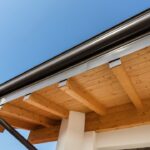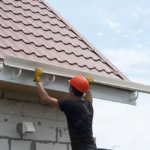Understanding how to calculate roof slope is an integral part of homeownership. For many homeowners, ensuring their roof is in prime condition involves knowing its slope, particularly when planning renovations or repairs. A roof’s slope, also known as its pitch, is crucial for effective water drainage and overall structural integrity.
The slope is not just about aesthetics; it’s a critical component for the functionality and longevity of a roof. Whether you’re planning to install a new roof or simply want to understand more about your current one, knowing the slope can inform what materials and designs will work best for you. Our guide will walk you through the details of calculating roof slope, so you can make informed decisions for your home.

Understanding Roof Slope
The term ‘roof slope‘ or ‘pitch‘ refers to the angle or steepness of a roof. It’s typically expressed as a ratio of the rise to the run in roof dimensions. The rise refers to the vertical change over a certain distance, and the run is the horizontal distance. Knowing these terms helps in visualizing and measuring the slope accurately.
Roof Slope Ratio Explained
A roof slope ratio is usually expressed in terms of vertical rise “in” inches for every 12 inches of horizontal run. For example, a 4:12 slope means the roof rises 4 inches vertically for every 12 inches horizontally. This measurement helps in selecting the right roof materials and design.
Why Roof Slope Is Important
Roof slope is vital for directing water away and preventing moisture build-up which can lead to structural issues. Steeper slopes provide better water runoff, minimizing leakage and other moisture problems. Conversely, low-slope roofs might need additional waterproofing to prevent water retention.
Tools for Measuring Roof Slope
Calculating the roof slope requires some practical tools:
- Level A standard level can help find the angle. More than one slope design.
- Measuring Tape To measure the length of the run and the rise accurately.
- Calculator For quick conversion and calculation of slope ratio.
- Roof Pitch Finder App A digital tool that can provide quick and accurate readings.
The Basic Step-by-Step Guide
Follow these basic steps to measure your roof slope:
- Place the level horizontally against the roof.
- Ensure it’s level using the built-in bubble.
- Mark 12 inches along the level, and measure vertically to the roof surface.
- The vertical measurement is the ‘rise’ over 12 inches ‘run.’
This simple procedure provides the roof slope ratio that reflects the pitch of your roof.
Types of Roof Slopes
Low Slope
Often found in industrial buildings, low-slope roofs have their pros and cons. They are easier to walk on and maintain but generally require more waterproofing to manage water run-off effectively.
Medium Slope
Popular for residential homes, medium slopes offer balanced aesthetics and functionality. They manage water run-off efficiently and provide adequate attic space.
Steep Slope
Ideal for heavy rain and snow, steep slopes create dramatic profiles and excellent water drainage. They require more material and labor but add to the home’s curb appeal significantly.
Choosing the Right Roof Slope for Your Home
When deciding on your roof slope, consider factors like climate, architectural style, and planned usage of attic space. If you live in an area with heavy snowfall or rainfall, a steeper pitch could be more beneficial to prevent leaks and structural damage. Roofing materials guide.
Modern Innovations in Measuring Roof Slope
Technological advancements have brought delightful innovations for measuring roof slopes. Use of lasers and apps have made it more straightforward than ever before, saving time and improving accuracy.
The Future of Roofing with Tremendous Innovation
Technology in the roofing industry is continually evolving. New tools and software applications for calculating roof slope are consistently getting approvals from professionals. Learn more about roof costs.
Sustainable Roofing
Sustainable roofing choices offer environmental benefits and enhance energy efficiency. Incorporating solar panels and reflective materials can optimize energy savings.
Conclusion
Knowing how to calculate roof slope gives you a tremendous advantage when planning home improvements. It is a vital step toward ensuring your roof is both functional and aesthetically pleasing.

FAQs
What is the most common roof slope?
The most common slope is between 4:12 and 9:12, which balances aesthetics and functionality in residential homes.
Can roof slope affect material costs?
Yes, steeper slopes can increase material costs due to additional coverage and complexity in design.
Are low-slope roofs suitable for heavy rain areas?
Low-slope roofs can work in such areas with proper waterproofing techniques, although steep slopes are generally preferred.
This article contains affiliate links. We may earn a commission at no extra cost to you.








